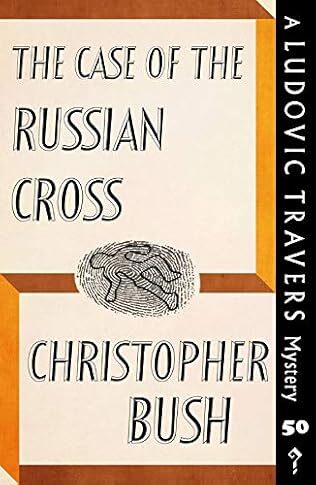The Case Of The Russian Cross

A review of The Case of the Russian Cross by Christopher Bush – 250425
To use a cricketing analogy, apt as some of the action takes place in the environs of Lord’s, when a batsman approach a landmark, they like to do it with style. In The Case of the Russian Cross, the fiftieth in his long-running Ludovic Travers series, originally published in 1957 and reissued by Dean Street Press, Bush hits the ball out of the ground for a six.
Those familiar with the works of Bush will be unsurprised to find him introducing three seemingly unconnected themes, following the Sibelian practice of introducing various short themes which may seem wholly unconnected but which by the end have been fused together into a satisfying whole, as he quotes from some programme notes in his preface. The strands are a blackmail attempt, the theft of some jewels including diamonds from the eponymous Russian Cross, and a murder.
In addition there are some familiar leitmotifs, a body badly charred found in the remains of a bonfire, see The Case of the Burnt Bohemian, Bush’s ongoing fascination with the fact that women change their hair colouring, see The Case of the Housekeeper’s Hair and others, and a clue that has lain staring in Travers’ face which had it been recognised at the time would have foreshortened the case considerably. The elements may be familiar and well-tested but like a master architect it is what he does with the same materials that shows his skills.
A change at the top at the Yard with the appointment of Forlin as the new Commander Crime sees Ludovic Travers out in the cold, a stickler for the proper and the conventional having no truck with the efforts of a dilettante amateur. Wharton is still in situ but plays a much reduced role in the story although he finesses a pleasing result at the end. The source of the three short themes is Travers’ other role, that of owner and Chairman of the Broad Street Detective Agency.
The first case is ultimately not pursued as Travers has reservations about his two clients, a Mrs Penford and a famous artist, Brian Sigott. The second comes from the Agency’s relationship with the United Assurance insurance company to look into the theft of some jewels that belong to a game old woman, Alyssia Rimmell, who later becomes the second murder victim. There is an unusual feature in the case in that an early photograph of the Russian Cross which Rimmell wore at a ball 60 years ago seems to show the diamonds missing while the wearer is adamant that they were there, a conundrum which is neatly and ingeniously explained as the case moves to its denouement.
The third is a request by Lilli North, a blonde Danish woman or so she says, to follow James Hover following his release from prison and advise her where he is staying that night. After a chase around London visiting places that have associations with other strands of the plot, the charred body Hover is ultimately found. This brings the Yard into the story in the form of Chief Inspector Jewle. Travers’ relationship with him is not as competitive as that with Wharton but, nevertheless, Travers treads a fine line between obstructing the police in their enquiries by withholding elements of what he knows to maintain the Agency’s advantage in resolving the mystery.
In his own measured way Bush moves with the times. There is a darker edge to the story. We no longer inhabit the corridors of the country house, hobnobbing with the leisured classes. We are now immersed into a world of con artists, pornographers, and blackmailers and Travers himself seems to have evolved into a more worldly wise character. It was good to see his wife, Bernice, play a more active role, even if her role is to play a part that conventionally would be assigned to a woman.
An impressive book which shows that even at the age of 72, there is still plenty of life left in Bush yet!



